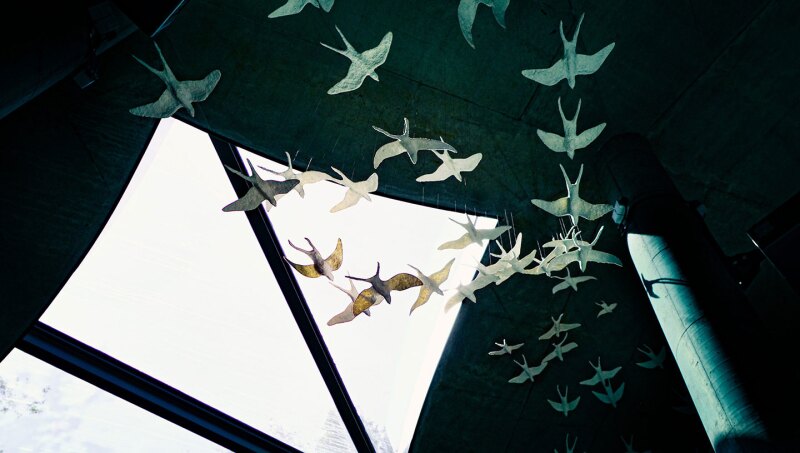Odense, childhood home of author Hans Christian Andersen and site of the new museum in his honor, was once a quaint, quiet city—a sort of fairy-tale village in its own right that could clearly inspire a vivid imagination. Cobbled streets and colorful hobbit-like buildings date back to the late 1800s; even now, parks and playgrounds numbering in the hundreds provide ample room for playing and daydreaming.
In recent years, the old shipping port and now third-largest city in Denmark—within two hours of Copenhagen and Aarhus—has been spruced up with pedestrian streets, a tram line, and the new Odeon Music and Theatre Center. The latest addition is the one that got me on a plane to Denmark: a new Hans Christian Andersen museum, designed by Japanese starchitect Kengo Kuma (known for the V&A Dundee and Tokyo Olympic Stadium), which opened in a ceremony with the Danish Queen Margrethe on June 30.
The H.C. Andersen House, as it’s officially known, builds off an original museum that was Andersen’s home from age 2 to 14. The city made more space available, turning a nearby highway into walkable streets, and so the museum began a new chapter: as a magnificent glass-and-wood circular structure, surrounded by undulating green spaces, that still connects to Andersen’s home.
This new museum is, unsurprisingly, intended to evoke a fairy tale. Creative director Henrik Lübker wanted the experience of sharing Andersen’s history to feel like you’re passing through a storybook—one that suits children and adults alike. “The idea was not just to talk about Hans Christian Andersen,” says Lübker. “He’s the world’s most famous fairy-tale author, but there was nothing [here] telling a fairy tale. We wanted to create an experience where things happen in the here and now—it should be a living thing.”

The art and architecture will entrance adults at the Hans Christian Andersen museum.
Photo by Laerke Beck Johansen/H.C. Andersen House
Visitors arrive from the “real world” at a glass-fronted entrance with timber beams—reminiscent of those found in old houses in Odense—and a new café from Nordic food pioneer and Noma cofounder Claus Meyer. From there they enter a room where an image of Andersen, a collage of photos, and sculpture on a screen come alive. Then visitors descend a ramp into a world where objects from Andersen’s life–a razor, writing pen–also seem to animate, while famous quotes from the author (“One heart is not enough for any woman!”) are printed on plaques.
“Throughout the museum we didn’t want it to be hyper-realistic. We wanted to keep it open so you can invest your imagination in it,” says Lübker. One feature uses an advanced audio system with a narrator who seems to strike up a conversation with visitors. When a viewer gets closer to an object, it begins to talk when the sensor is activated.
“[Andersen] popularized the idea of giving voices to things,” says Lübker. “He’s constantly asking: What is this human sense of notion? We all have perspectives, so from where should the point of view of the fairy tale be? Who should narrate this story? The sun? The wind?” At the museum, every object—including souvenirs from his life, like a top hat—has an opportunity to share its story.

Visitors can interact with the exhibits, like this metallic nightingale.
Photo by Laerke Beck Johansen/H.C. Andersen House
Andersen’s children’s stories quickly become morality tales, so the team wanted to recreate this shift and lead the visitor on a personal journey. To present a playful conversation between the museum’s objects from various narrators, the team enlisted expert dialogue-writer Daniel Handler, author of the Lemony Snicket children’s book series, to write the script. According to Lübker, “We needed to have playful banter. There’s a constant play between the objects—all thinking they should be the most important part of the story.
Many of Andersen’s major characters make appearances throughout the museum. The Little Match Girl has been recreated by a puppeteer (who worked on films by Tim Burton and by Wes Anderson) and then filmed in stop-motion. Viewers are able to control the Little Match Girl’s narrative by pressing a button. “We are the voyeurs in the story,” says Lübker.
Items from the archives are on display, such as collections of Andersen’s drawings, paper cuttings, and writings, but most visitors will likely be drawn to the rooms where 12 of Andersen’s most famous fairy tales have been peeled from the pages. There’s a space where you can play with your shadow, or turn the handle of a metallic nightingale. And, of course, there’s a Little Mermaid room where visitors lie beneath a window of water.
In true Andersen style, this experience isn’t without meaning. Those under the window, illuminated by a soft ray of blue light, are brought into the narrative through the sound of other mermaids singing and talking about them. “The idea is that you feel a sense of longing, that the fairy tales become facilitators,” says Lübker. “You look up to the sky and question what you need in your world.” The last chapter of this story is the Ugly Duckling room–an allegory to sum it all up. Those familiar with the fairy tale will know it’s about a duckling that’s rejected because it looks different. “Who hasn’t felt alone in their life?” asks Lübker. Will we emerge not caring what other people think of us?
Leaving the museum, you can’t help but feel like you’ve arrived from the rabbit hole of another (non-Andersen) storybook, Alice in Wonderland. The shiny center of Odense, with its new trams and buildings, awaits. Much like Andersen’s fairy tales, which are ingrained in many childhood memories, the experience sticks. It offers a playful and poignant reminder to listen a little better and try harder to understand people’s different perspectives. Always apropos, but especially in 2021.
>>Next: The AFAR Guide to Copenhagen











